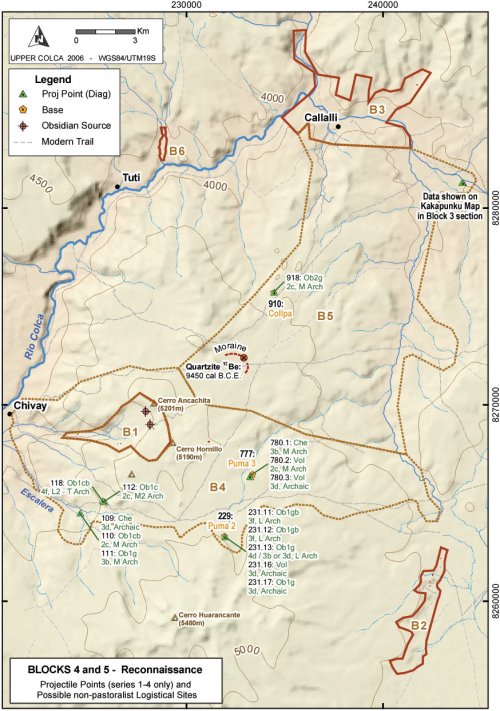Blocks 4 and 5 Reconnaissance Areas
The expansive Block 4 and 5 areas were evaluated opportunistically rather than systematically in the course of the 2003 fieldwork; and these blocks were examined to a limited extent during preliminary research in 2002. The targeted nature of this work in these blocks precludes any systematic evaluation of site distributions and settlement patterns because of biased survey coverage, however hiking across these reconnaissance areas provides a measure of the variety in each block. Data from the survey of these reconnaissance blocks provide insight into the access that these zones offer to the Chivay source, as well as the initial obsidian production activities that occurred there.
Figure6-12. Map of project area showing Reconnaissance Blocks 4 and 5 with diagnostic projectile points and logistical sites from the Archaic Foragers period.
As with the settlement pattern in other lava rock areas of in the study zone, the arid and patchy environment of these blocks resulted in a relatively high rate of site reoccupation. The prevailing occupation pattern for the Archaic in Blocks 4 and 5 appear to consist of a few relatively large camps that are typically less than a few hundred meters from water, and often close to some kind of topographic prominence that offers both shelter and a view of the surrounding terrain. Isolated finds are also relatively frequent as should be expected of distributed subsistence, based on foraging.
The evidence points to an Early Holocene deglaciation of the Chivay Source area. A10Be date acquired from a quartzite erratic on a moraine to the east of the Chivay source area (data courtesy of Daniel Sandweiss, 2006), suggests that the terrain surrounding the source was glaciated at the 4650 masl level and higher as late as the Early Holocene (Figure 6-12and Figure 4-15). Establishing the rate of deglaciation for the different areas that may have been exposed in a given time period will require further glaciological study.
A03-229 "Puma 2" [A03-229 - A03-232]
This rock shelter, and the slopewash below it, is one of the more effective shelters occupied during the Archaic in this area. The shelter is above an active corral and immediately south of a medium sized estancia owned by the Puma family. At this rock shelter, a longer incidence of occupation is suggested by a higher density of lithics. The rock shelter itself is something of a tunnel with two entrances as a result of a collapse in the center portion of the shelter. Both entrances have had walls constructed across them, and the northern of the two walled entrances is visible in Figure 6-13.
Figure 6-13. Rock shelter [A03-229] passes behind the collapsed margin of the grey lava flow in the center of the photo. Walls are built to partially close off both of the two entrances.
This shelter faces the morning sun and perennial water is available in a stream approximately 300m east. Unfortunately the construction of a large corral, on a relatively steep (10°) slope (the upper wall of which is visible in Figure 6-13), has resulted in a great deal of disturbance for artifacts just below this shelter. The many projectile points identified here were found among the stirred-up debris at lower end of this sloping corral.
|
Ob1 |
Ob2 |
Volcanics |
Chert |
Total |
|
|
Biface |
1 |
1 |
|||
|
Biface Broken |
2 |
3 |
5 |
||
|
Flake Broken |
8 |
8 |
|||
|
Flake Complete |
1 |
1 |
2 |
||
|
Flake Retouched |
1 |
1 |
|||
|
Flake Retouched Broken |
1 |
1 |
2 |
||
|
Proj Point |
1 (3d) |
1 |
|||
|
Proj Point Broken |
5 (3f,3d,unk) |
1 (unk) |
6 |
||
|
Total |
9 |
5 |
1 |
11 |
26 |
Table6-21. Lithic artifacts from site A03-229 excluding eleven Series 5 projectile points.
This site contained a substantial number of points that are possibly Late Archaic, although the site also contained eleven Series 5 Term Archaic - Late Horizon points made from homogeneous Ob1 obsidian (that accounted for 60% of all projectile points by weight), but these were excluded from Table 6-1 because they are not Archaic. Based on the condition of the partially worked artifacts, much of this surface assemblage appears to have been abandoned during middle stage reduction in point production. One of the points was fine-grained volcanic, and had incomplete scar coverage. Of the obsidian artifacts, 45% of the projectile points and other bifacially flaked implements had incomplete scar coverage, and 66% were broken. These data suggest that this area, within a day's travel of the obsidian source, represented an intermediate stage in the lithic reduction trajectory as one departs the source. Interestingly, only 16% of the obsidian artifacts contained heterogeneities (Ob2) and these implements were nearly all classified as bifaces rather than as points. Ob2 obsidian was observed occurring as surface gravels only 4 km from this site, and the Maymeja source of Ob1 obsidian is nearly double that distance as the condor flies. Although this may be a signal from the later pastoral period, when shearing and other expedient uses for obsidian expanded, there appears to have been an emphasis on the use of Ob1 obsidian for point production while Ob2 obsidian was used for other bifacial tools.
Unfortunately, due to the disturbed state of the slope from the corral, and the artifact breakage that can result from animal trampling, further analyses of these data does not appear to be worthwhile. Future test excavations in the rock shelter may offer more insights into activities in this intermediate zone.


